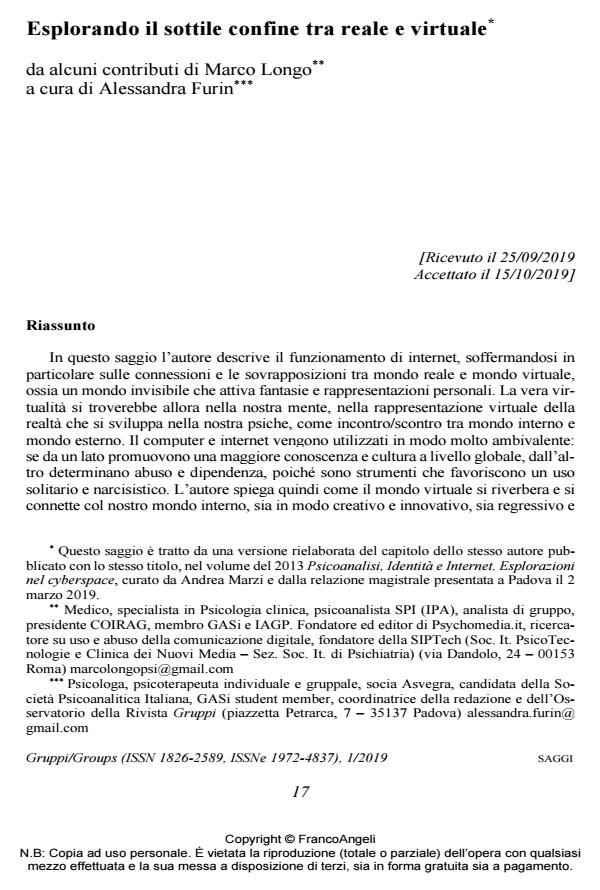Real world and virtual world: exploring the subtle boundary in-between
Journal title GRUPPI
Author/s Marco Longo, Alessandra Furin
Publishing Year 2019 Issue 2019/1
Language Italian Pages 13 P. 17-29 File size 194 KB
DOI 10.3280/GRU2019-001003
DOI is like a bar code for intellectual property: to have more infomation
click here
Below, you can see the article first page
If you want to buy this article in PDF format, you can do it, following the instructions to buy download credits

FrancoAngeli is member of Publishers International Linking Association, Inc (PILA), a not-for-profit association which run the CrossRef service enabling links to and from online scholarly content.
In this essay, the author explains how the internet works, underlining the con-nections and juxtapositions between real world and virtual world, that is, focusing on an invisible world activating fantasies and personal representations. True virtu-ality seems to reside in our minds, in the virtual representation of reality that de-velops in our psyche, where inner world and outer world meet and clash. Comput-ers and the internet are used in a very ambivalent way: if, on the one hand, they promote knowledge and create culture worldwide, on the other they favour a soli-tary and narcissistic use of digital devices, which can easily turn into abuse or ad-diction. The author then explains why the virtual world reverberates in and con-nects with our inner world, both in a creative and innovative, as well as in a regres-sive and pathological way. In cyberspace, each user is virtually in touch synchron-ically, in a one-to-one relationship, with all other "knot points of the web", within a "shared, invisible space", a multiform and multidimensional "topological space" where distance and closeness, emptiness rarefaction and total fullness, impotence and omnipotence, reality and fantasy are all present simultaneously. There follows a description of social networking and virtual worlds: their success, their limits and, specifically, their abuse can only be analyzed - from a psychological and psycho-analytic point of view - by means of group and psychosocial models. Cyberbully-ing, a widespread pathology among adolescents nowadays, and the everincreasing threat of pedopornography are also discussed.
Keywords: Internet, Virtual world, Dissociative disorder and digital media abuse, Cyberbullying, Pedopornography.
- La relazione clinica mediata dallo schermo nella psicoterapia di gruppo online Ivan Ambrosiano, Vanda Druetta, Anna Pisterzi, Salvatore Gullo, in GRUPPI 2/2021 pp.91
DOI: 10.3280/gruoa2-2020oa12583 - Narrative digitali. Le dinamiche affettive legate all’oggetto digitale indagate con metodi proiettivi Michela Brunori, Maria Gabriella Pediconi, in Ricerca Psicoanalitica /2025
DOI: 10.4081/rp.2025.945 - Young sociologists in the mirror: digital ethnographies of young people online Nadia Crescenzo, in Frontiers in Sociology 1197560/2023
DOI: 10.3389/fsoc.2023.1197560
Marco Longo, Alessandra Furin, Esplorando il sottile confine tra reale e virtuale in "GRUPPI" 1/2019, pp 17-29, DOI: 10.3280/GRU2019-001003